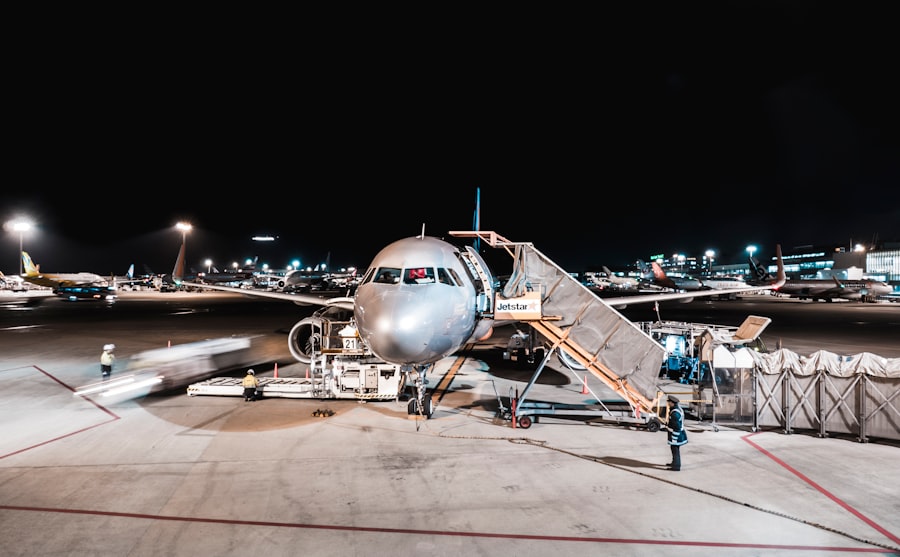
An Aircraft Launch and Recovery Officer (ALRO) plays a pivotal role in the operations of military and naval aviation, ensuring the safe and efficient launch and recovery of aircraft. This position is critical, particularly on aircraft carriers, where the unique environment and constraints demand a high level of expertise and coordination. The ALRO is responsible for overseeing the entire process of launching and recovering aircraft, which includes managing personnel, coordinating with various departments, and ensuring adherence to safety protocols.
Their work is not only about the technical aspects of flight operations but also involves leadership and communication skills to effectively manage teams in high-pressure situations. The responsibilities of an ALRO extend beyond mere oversight; they are integral to mission success. They must possess a deep understanding of aircraft systems, flight operations, and the specific procedures that govern launch and recovery activities.
This includes knowledge of the various types of aircraft involved, their capabilities, and limitations. The ALRO must also be adept at using advanced technology and equipment that facilitate these operations, such as catapults, arrestor wires, and landing systems. Their role is crucial in maintaining operational readiness and ensuring that all missions are executed safely and efficiently.
Key Takeaways
- An Aircraft Launch and Recovery Officer (ALO) is responsible for coordinating the launch and recovery of aircraft on an aircraft carrier.
- Training and education requirements for ALOs typically include a bachelor’s degree in a related field and completion of the Navy’s ALO training program.
- ALOs are responsible for ensuring the safety and efficiency of aircraft launch and recovery operations, as well as coordinating with flight deck personnel and air traffic control.
- Career opportunities for ALOs may include advancement to higher ranks within the Navy or transitioning to civilian aviation management roles.
- ALOs can expect to receive competitive salaries and benefits, including healthcare, retirement plans, and housing allowances.
Training and Education Requirements
Education and Background
Most ALROs start their careers in the military, often as commissioned officers in the Navy or Marine Corps. A bachelor’s degree in aviation management, aerospace engineering, or a related field is generally preferred, as it provides a solid foundation in the principles of flight operations and aircraft systems.
Alternative Pathways
However, some individuals may enter the role through other pathways, such as technical training or experience in related fields.
Training and Preparation
Once selected for the position, aspiring ALROs undergo rigorous training programs that include both classroom instruction and hands-on experience. This training covers a wide range of topics, including flight safety protocols, aircraft handling procedures, and emergency response techniques. Additionally, candidates learn about the specific equipment used in launch and recovery operations, such as catapults for launching aircraft and arrestor wires for landing. The training process is designed to ensure that ALROs are well-prepared to handle the complexities of their role and can make quick decisions in dynamic environments.
Job Responsibilities and Duties

The job responsibilities of an Aircraft Launch and Recovery Officer are multifaceted and require a high level of attention to detail. One of their primary duties is to coordinate the launch and recovery sequences of aircraft, which involves meticulous planning and execution. This includes assessing weather conditions, monitoring aircraft readiness, and ensuring that all personnel are in position before an operation begins.
The ALRO must communicate effectively with pilots, ground crews, and other officers to ensure that everyone is aware of their roles during these critical phases. In addition to operational coordination, ALROs are also responsible for maintaining safety standards throughout the launch and recovery process. They conduct pre-launch checks to verify that all systems are functioning correctly and that safety equipment is in place.
During recovery operations, they monitor landing procedures closely to ensure that aircraft land safely on deck. This requires a keen understanding of aerodynamics and the specific characteristics of each aircraft type. Furthermore, ALROs often participate in debriefings after missions to analyze performance and identify areas for improvement, contributing to ongoing training and operational excellence.
Career Opportunities and Advancement
| Metrics | Data |
|---|---|
| Job Openings | 200 |
| Promotion Rate | 15% |
| Employee Turnover | 10% |
| Training Opportunities | Yes |
Career opportunities for Aircraft Launch and Recovery Officers can be quite diverse within military aviation. Many ALROs start their careers in entry-level positions but can advance to higher ranks with experience and demonstrated competence. Advancement may lead to roles such as Operations Officer or even Commanding Officer of an air wing or carrier group.
These positions come with increased responsibilities, including strategic planning for air operations and oversight of larger teams. Moreover, ALROs can also transition into civilian roles within the aviation industry after their military service. Their skills are highly transferable to commercial aviation operations, airport management, or aviation safety roles.
Some may choose to work for defense contractors or government agencies involved in aviation safety regulation or air traffic control. The experience gained as an ALRO provides a strong foundation for leadership positions in various sectors related to aviation.
Salary and Benefits
The salary for an Aircraft Launch and Recovery Officer can vary significantly based on factors such as rank, years of service, and location. In the military context, ALROs are typically compensated according to military pay scales, which include base pay along with allowances for housing, food, and other benefits. As they advance in rank, their salaries increase correspondingly.
For example, a junior officer may earn a base salary starting around $50,000 annually, while more senior officers can earn upwards of $100,000 or more depending on their rank and years of service. In addition to salary, ALROs enjoy a range of benefits associated with military service. These benefits often include comprehensive healthcare coverage, retirement plans, education assistance programs, and opportunities for professional development.
The military also provides unique experiences that can enhance personal growth and leadership skills. For those who transition into civilian roles after their military career, the skills acquired as an ALRO can lead to competitive salaries in the aviation industry.
Work Environment and Conditions

The work environment for an Aircraft Launch and Recovery Officer is dynamic and often high-stress due to the nature of flight operations. ALROs typically work on aircraft carriers or at naval air stations where they are exposed to various weather conditions and operational challenges. The environment can be noisy due to aircraft engines and deck operations, requiring effective communication skills to relay instructions clearly amidst the chaos.
ALROs must also be prepared for irregular hours since flight operations can occur at any time of day or night. This unpredictability necessitates a high level of adaptability and resilience. Safety is paramount in this role; therefore, ALROs must remain vigilant at all times to ensure that all procedures are followed meticulously to prevent accidents or mishaps during launch or recovery operations.
Job Outlook and Demand
The job outlook for Aircraft Launch and Recovery Officers remains stable due to the ongoing need for skilled personnel in military aviation. As long as there are naval operations requiring air support, there will be a demand for qualified ALROs who can manage complex launch and recovery processes effectively.
Moreover, as military forces around the world continue to modernize their fleets and enhance operational capabilities, the demand for experienced officers who can oversee these operations will likely grow. Additionally, many former ALROs find opportunities in civilian aviation roles where their expertise is highly valued. This trend suggests a positive outlook for those pursuing a career as an Aircraft Launch and Recovery Officer.
How to Pursue a Career as an Aircraft Launch and Recovery Officer
To pursue a career as an Aircraft Launch and Recovery Officer, individuals should start by exploring educational pathways that align with their interests in aviation. A bachelor’s degree in fields such as aviation management or aerospace engineering is beneficial but not always mandatory for entry into military service. Prospective candidates should consider enlisting in the military or applying for officer training programs if they wish to pursue a commission.
Once in the military, candidates will undergo specialized training tailored to their future roles as ALROs. It is essential to demonstrate strong leadership qualities, effective communication skills, and a commitment to safety throughout this training process. Networking with experienced officers can provide valuable insights into the role’s demands and expectations.
Additionally, seeking mentorship from seasoned ALROs can help aspiring officers navigate their career paths effectively while gaining practical knowledge that will serve them well in their future roles within aviation operations.
If you are interested in learning more about careers in the USA, specifically as Aircraft Launch and Recovery Officers, you may want to check out this related article on careersintheusa.com. This website offers valuable information and resources for individuals looking to explore various career paths in the United States. Whether you are just starting out in your career or looking to make a career change, careersintheusa.com can provide you with the guidance and insights you need to succeed.
FAQs
What is an Aircraft Launch and Recovery Officer (ALO)?
An Aircraft Launch and Recovery Officer (ALO) is a commissioned officer in the United States Navy or Marine Corps who is responsible for the safe and efficient launch and recovery of aircraft from aircraft carriers.
What are the primary responsibilities of an Aircraft Launch and Recovery Officer?
The primary responsibilities of an Aircraft Launch and Recovery Officer include coordinating the movement of aircraft on the flight deck, ensuring the safety of flight operations, and managing the launch and recovery of aircraft.
What qualifications are required to become an Aircraft Launch and Recovery Officer?
To become an Aircraft Launch and Recovery Officer, individuals must be commissioned officers in the United States Navy or Marine Corps. They must also have completed specific training and have experience in aviation operations.
What are the career prospects for Aircraft Launch and Recovery Officers?
Aircraft Launch and Recovery Officers have the opportunity to advance to higher ranks within the military and take on leadership roles in aviation operations. They may also transition to civilian careers in aviation management or related fields after completing their military service.



